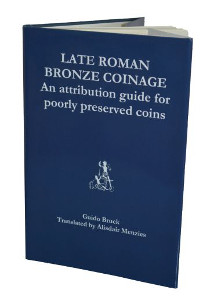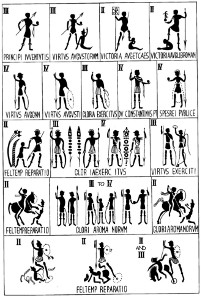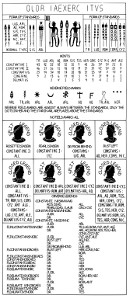May 7, 2015 – Guido Bruck’s “Die spätrömische Kupferprägung”, published in 1961, has been reedited in English. Alisdair Menzies has taken over this meritorious project which surely will help many friends of Roman coinage to describe poorly preserved coins.
More than fifty years after it went out of print, one of the more unusual and sought after numismatic works on fourth century Roman bronze coins has been reedited and translated into English.
Guido Bruck, Late Roman Bronze Coinage – An attribution guide for poorly preserved coins. Translated by Alisdair Menzies. 2015, 148 pages, Paperback. ISBN: 978-1502926012. $22.50.
Guido Bruck’s “Die spätrömische Kupferprägung”, originally published in 1961, is now available under the title “Late Roman Bronze Coinage – An attribution guide for poorly preserved coins”.
Amongst the most common ancient artefacts encountered by archaeologists in Europe is the fourth century Roman bronze coin. Relatively few coins, however, are sufficiently well preserved to easily identify using traditional numismatic literature. Guido Bruck, a curator at the Kunsthistorisches Museum in Vienna from 1948 to 1966 had access to the finest collection of late Roman coins in the world, but was also faced with the sometimes fastidious task of having to identify coin finds which were not of museum quality.
Traditional numismatic literature is very much text based. Faced with incomplete or worn specimens, most people would find it very time consuming to come up with a precise identification using traditional texts such as the Roman Imperial Coinage. However, if one pays attention, there are often clues in the images which allow for a precise identification of the type, Emperor or Caesar and mint, even in the absence of complete legends or mintmarks.
Bruck therefore devised this book which is very useful to both numismatists and archaeologists, containing beautiful line drawings of more than 100 types of late Roman bronze coins. Line drawings are much more useful than photos in this context because they allow the user to focus on the details that matter in distinguishing between the types, emperors and mints.
The first section of the book allows the reader to quickly identify the type. In the second section, each type is presented in detail. The differences in design between the mints for both the obverse and reverse are illustrated. Coin sizes are given, obverse and reverse legend variations are listed together with the various field marks. All of the essential information is therefore given in one place, allowing for a relatively quick identification.
The ease of use of this book will be appreciated by both archaeologists and numismatists. It is remarkable how many clues are available if one pays attention. But it should be emphasised that beyond its practical use in identifying coins, this book is valuable in providing a wonderfully illustrated overview of the iconography of the coin types of the fourth century.
You can purchase the book on Amazon.







